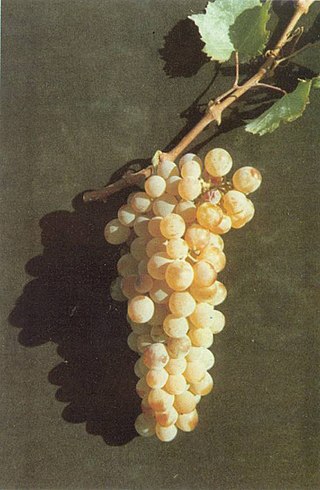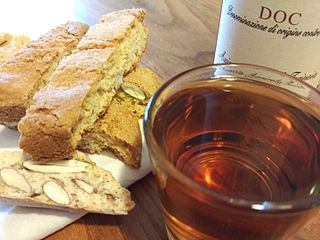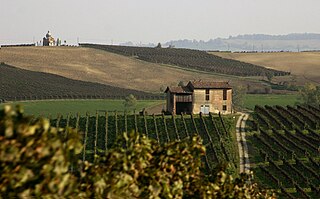
Malvasia is a group of wine grape varieties grown historically in the Mediterranean region, Balearic Islands, Canary Islands and the island of Madeira, but now grown in many of the winemaking regions of the world. In the past, the names Malvasia, Malvazia, and Malmsey have been used interchangeably for Malvasia-based wines; however, in modern oenology, "Malmsey" is now used almost exclusively for a sweet variety of Madeira wine made from the Malvasia grape. Grape varieties in this family include Malvasia bianca, Malvasia di Schierano, Malvasia negra, Malvasia nera, Malvasia nera di Brindisi, Malvasia di Candia aromatica, Malvasia odorosissima, and a number of other varieties.

Valpolicella is a viticultural zone of the province of Verona, Italy, east of Lake Garda. The hilly agricultural and marble-quarrying region of small holdings north of the Adige is famous for wine production. Valpolicella ranks just after Chianti in total Italian Denominazione di Origine Controllata (DOC) wine production.

White wine is a wine that is fermented without skin contact. The colour can be straw-yellow, yellow-green, or yellow-gold. It is produced by the alcoholic fermentation of the non-coloured pulp of grapes, which may have a skin of any colour. White wine has existed for at least 4,000 years.

A rosé is a type of wine that incorporates some of the color from the grape skins, but not enough to qualify it as a red wine. It may be the oldest known type of wine, as it is the most straightforward to make with the skin contact method. The pink color can range from a pale "onionskin" orange to a vivid near-purple, depending on the grape varieties used and winemaking techniques. Usually, the wine is labelled rosé in French, Portuguese, and English-speaking countries, rosado in Spanish, or rosato in Italian.

Collioure is an Appellation d'Origine Contrôlée (AOC) for French wines situated around the town of Collioure in the Roussillon wine region of France. Red, rosé and a few white wines are produced-the reds from Grenache noir, Mourvèdre, Syrah, Carignan and Cinsaut grapes; the white are made from a blend of Grenache blanc and Grenache gris. The boundaries of the AOC are identical with the Banyuls AOC as many of the grapes grown in Collioure are destined for use in the fortified Vins doux naturels of the region. The grapes that do not get used for Banyuls are then produced as non-fortified still wines under the Collioure AOC.

Italian wine is produced in every region of Italy. Italy is the world's largest producer of wine, with an area of 702,000 hectares under vineyard cultivation, and contributing a 2013–2017 annual average of 48.3 million hl of wine. In 2018 Italy accounted for 19 per cent of global production, ahead of France and Spain. Italian wine is both exported around the world and popular domestically among Italians, who consume an average of 42 litres per capita, ranking fifth in world wine consumption.

Assyrtiko or Asyrtiko is a white Greek wine grape indigenous to the island of Santorini. Assyrtiko is widely planted in the arid volcanic-ash-rich soil of Santorini and other Aegean islands, such as Paros. It is also found on other scattered regions of Greece such as Chalkidiki. Assyrtiko is also being grown by Jim Barry Wines in Clare Valley, South Australia, at the Abbey of New Clairvaux in Northern California since 2011, and at Kefi Winery in Monroe, North Carolina by a first generation Greek family. The original Assyrtiko cuttings were imported in the USA in 1948 by Harold Olmo, grape breeder at the University of California, Davis, where they were stored until the abbey of New Clairvaux took interest in the early 2000s.

Greece is one of the oldest wine-producing regions in the world and among the first wine-producing territories in Europe. The earliest evidence of Greek wine has been dated to 6,500 years ago where wine was produced on a household or communal basis. In ancient times, as trade in wine became extensive, it was transported from end to end of the Mediterranean; Greek wine had especially high prestige in Italy under the Roman Empire. In the medieval period, wines exported from Crete, Monemvasia and other Greek ports fetched high prices in northern Europe. The most famous Greek wine is the Retsina. Its name comes from an ancient Greek tradition of keeping the wine in resinous barrels.

French wine is produced all throughout France, in quantities between 50 and 60 million hectolitres per year, or 7–8 billion bottles. France is one of the largest wine producers in the world, along with Italian, Spanish, and American wine-producing regions. French wine traces its history to the 6th century BCE, with many of France's regions dating their wine-making history to Roman times. The wines produced range from expensive wines sold internationally to modest wines usually only seen within France such as the Margnat wines of the post war period.
The glossary of wine terms lists the definitions of many general terms used within the wine industry. For terms specific to viticulture, winemaking, grape varieties, and wine tasting, see the topic specific list in the "See also" section below.

Vin Santo[vin ˈsanto] is a style of Italian dessert wine. Traditional in Tuscany, these wines are often made from white grape varieties such as Trebbiano and Malvasia, though Sangiovese may be used to produce a rosé style known as "Occhio di Pernice" or eye of the partridge. The wines may also be described as straw wines since they are often produced by drying the freshly harvested grapes on straw mats in a warm and well ventilated area of the house. Though technically a dessert wine, a Vin Santo can vary in sweetness levels from bone dry to extremely sweet. While the style is believed to have originated in Tuscany, examples of Vin Santo can be found throughout Italy and it is an authorised style of wine for several Denominazione di origine controllata (DOCs) and Indicazione geografica tipica (IGTs).

Straw wine, or raisin wine, is a wine made from grapes that have been dried to concentrate their juice. The result is similar to that of the ice wine process, but is a much older process and suitable for warm climates. The technique dates back to pre-Classical times with wines becoming fashionable in Roman times and in late Medieval/Renaissance Europe when wines such as Malmsey and Candia were highly sought after. Traditionally, most production of these wines has been in Greece, the islands of Sicily, Cyprus, Northern Italy and the French Alps. However, producers in other areas now use the method as well.
Greco is an Italian wine grape that may be of Greek origin. The name relates to both white (Greco bianco) and black (Greco nero) grape varieties. While there is more land area dedicated to Greco nero, the Greco bianco is the grape most commonly referred to by "Greco". In the Campania region it is used to produce the Denominazione di Origine Controllata e Garantita (DOCG) wine Greco di Tufo. In Calabria, it is used to make the Denominazione di Origine Controllata (DOC) wine Greco di Bianco. The name "Greco" is sometimes used as a synonym for several varieties of supposed Greek origins-most notably Trebbiano.

Slovenian wine is wine from Slovenia. Viticulture and winemaking has existed in this region since the time of the Celts and Illyrians tribes, long before the Romans would introduce winemaking to the lands of France, Spain and Germany.

Luxembourg wine is primarily produced in the southeastern part of the Grand Duchy of Luxembourg, with vineyards overlooking the river Moselle. Along this river, which for 42 km makes up part of the border between Luxembourg and Germany, wine is made in three countries. There is a continuous history of winemaking along Moselle and in Luxembourg going back to Ancient Roman times. Wine production in 2006/07 was 123,652 hectoliter from 1,237 hectares of vineyards. Out of total wine exports of 87,776 hectoliter in 2005/06, 71,726 hectoliter or 82% was exported to nearby Belgium. Exports to Germany were the second largest at 8,168 hectoliter, or 9%, and is to a large extent made up of base wine in bulk for the production of blended Sekt rather than being sold bottled with "Luxembourg" anywhere on the label. Therefore, very little Luxembourg wine is seen outside Luxembourg and Belgium.

Corsica wine is wine made on the Mediterranean island of Corsica. Located 90 km west of Italy, 170 km southeast of France and 11 km north of the island of Sardinia, the island is a territorial collectivity of France, but many of the region's winemaking traditions and its grape varieties are Italian in origin. The region's viticultural history can be traced to the island's settlement by Phoceans traders in 570 BC in what is now the commune of Aléria. In the 18th century, the island came under the control of France. Following the independence of Algeria from French rule, many Algerian Pieds-Noirs immigrated to Corsica and began planting vineyards. Between 1960 and 1976 the vineyard area in Corsica increased fourfold. In 1968, Patrimonio was established as Corsica's first Appellation d'origine contrôlée (AOC). Today, Corsica has nine AOC regions including the island-wide designation Vin de Corse AOC. The majority of the wine exported from Corsica falls under the Vin de pays designation Vin de Pays de l'Île de Beauté. The three leading grape varieties of the region are Nielluccio (Sangiovese), known as the spice wine of France, Sciacarello and Vermentino.
This glossary of winemaking terms lists some of terms and definitions involved in making wine, fruit wine, and mead.

The Colli Piacentini are an Italian wine region located at the western end of Emilia-Romagna. In 1967, the region was given the denominazione di origine controllata (DOC) quality designation. Within its boundaries are several smaller DOCs including Colli Piacentini Gutturnio, Monterosso Val D'Arda DOC, Trebbianino Val Trebbia DOC, and Val Nur del Colli Piacentini DOC. The region has a long history of winemaking with fossilized vine roots and grape seeds excavated from the region showing viticulture taking place as early as 2000 BC. In Roman times, Julius Caesar's father-in-law Lucius Calpurnius Piso Caesoninus, grew grapes in the Piacenza hills.
Verdea is a white Italian wine grape variety that originated in Tuscany but is today mainly grown in the Lombardy wine region of northern Italy. The grape is sometimes confused with the white Verdeca grape of the Apulia region and the French wine grape Verdesse from Savoy due to similarities in their names and synonyms. Verdea can be used to make a wide variety of wines, ranging from the late harvested Vin Santo to dry sparkling wines.

Nosiola is a white Italian wine grape variety that is grown in the Trentino region north of Lake Garda in the Valle dei Laghi. Here it is used in varietal Denominazione di origine controllata (DOC) wines and as a blending component in wines such as Sorni Bianco from Trento. It is also used to produce a dessert wine in the Vin Santo style from grapes that have been allowed to dry out prior to fermentation.






















